/ Home / Attractions / Plaça de la MercèPrint version
Plaça de la Mercè
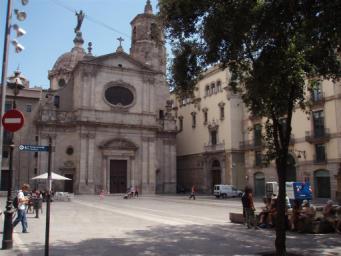 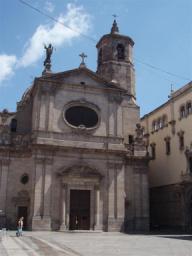 .JPG.medium.jpg) .JPG.medium.jpg)
|
.jpg.medium.jpg)
|
Historic information
The Plaça de la Mercè takes its name from the church of Our Lady of Mercy (La Mercè), which was designed by the architect Josep Mas and completed in 1775. Six years before the church’s centenary, the Pope gave his permission for La Mercè to be declared the city’s patron saint. For many years, the rector of the church tried unsuccessfully to have a block of houses located in front of the church demolished in order to create a square that would show weddings held at the church in all their splendour. Following the restoration of democracy (1976), the district around La Mercè underwent significant urban redevelopment which led to the demolition of the block of houses between the Carrer Ample, Carrer Louis Braille, Carrer de la Mercè and Carrer Voltes, which began in 1982, providing a new, wider space, and creating the present-day square.
In order to know the zone better
The church of La Mercè overlooks one end of the rectangular square and the Neptune Fountain, surrounded by holm oaks, stands at the other. On the west side stand the façades of the former premises of the Sociedad del Crédito Mercantil and the building at number 13 of the Carrer Ample, which is now the home of the design school, the Escola Superior de Disseny Elisava. On the east side of the square are three different buildings divided by party walls, but with enough common elements on their façades to lend them a certain unity. On the same side, at the end closest to the church, is the corner of the former convent of La Mercè, now the military headquarters, or Capitanía General, with a marble doorway dating from the mid-17th century.
The church of La Mercè was designed by Josep Mas and built between 1765 to 1775, according to the canons of the Counter-Reformation. It has a Latin-cross ground plan with a tower and dome over the crossing. The façade is of particular interest as it is the only example of Barcelona baroque to combine a flat frontage and concave walls. The shrine where people come to worship the Gothic image of Our Lady of Mercy was added in 1888 and is attributed to Pere Moragues. It is also of considerable importance as this type of structure is not commonly found in a city church. The Neptune Fountain, by Adrià Ferran, first stood in Barcelona harbour where it was inaugurated in 1826. It was then moved to Montjuïc Hill, and transferred to its present site in 1983 when the new Plaça de la Mercè was opened,. The buildings at number 10 and 12 in the square were refurbished in the early 1990s and house the vice-chancellor’s office and other services of the Universitat Pompeu Fabra. The square stands close to the Passeig de Colom and La Rambla.
The church of La Mercè was designed by Josep Mas and built between 1765 to 1775, according to the canons of the Counter-Reformation. It has a Latin-cross ground plan with a tower and dome over the crossing. The façade is of particular interest as it is the only example of Barcelona baroque to combine a flat frontage and concave walls. The shrine where people come to worship the Gothic image of Our Lady of Mercy was added in 1888 and is attributed to Pere Moragues. It is also of considerable importance as this type of structure is not commonly found in a city church. The Neptune Fountain, by Adrià Ferran, first stood in Barcelona harbour where it was inaugurated in 1826. It was then moved to Montjuïc Hill, and transferred to its present site in 1983 when the new Plaça de la Mercè was opened,. The buildings at number 10 and 12 in the square were refurbished in the early 1990s and house the vice-chancellor’s office and other services of the Universitat Pompeu Fabra. The square stands close to the Passeig de Colom and La Rambla.
|
Scene description
Perfume: The Story of a Murderer
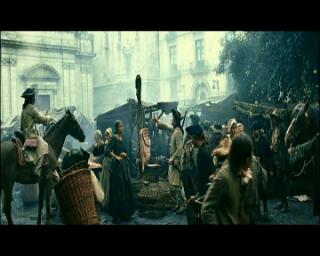 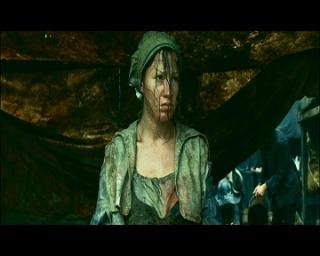 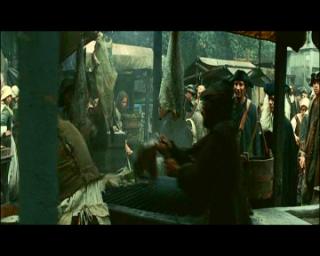
Plaça de la Mercè: This square was the setting for two key scenes from the film: the birth and death of Jean-Baptiste Grenouille (Ben Whishaw). The first sequence features a filthy, foul-smelling fish market, where a young girl (Birgit Minichmayr) gives birth to a child under one of the stalls and abandons him among the rotting scraps. She carries on working, waiting for the newly born infant to die, but, this time, the child lets out a squeal which alerts some of the people shopping at the stall. The mother tries to run away but she is arrested and sentenced to death at the gallows. In the final scene, Grenouille finds himself in the same square. He douses himself with the hypnotic perfume he has created, and the effect is so overpowering that he is engulfed by the crowd who tear him to pieces and devour him.
|
Did you know that...
The Plaça de la Mercè was used as the setting for the fish market on the Rue aux Fers in 18th-century Paris. The decoration of the square proved extremely time-consuming as the production team wanted to provide an authentic and convincing recreation of a gloomy, insalubrious and repellent Paris, as it was depicted in Suskind’s novel. 2.5 tons of fish and 1 ton of meat were used during filming. The result is so amazing that it is hard to recognise the square in the film. The scene of Jean-Baptiste Grenouille’s birth under the fish stall was shot on the first day of filming. Tykwer wanted to use a newly born baby for greater realism and this meant that the shots featuring the child were filmed in a hospital using sterilised rubbish.
|
The Barcelona of Perfume
/
Plaça de la Mercè

